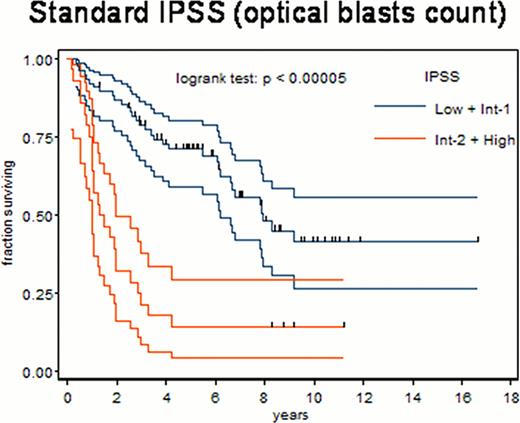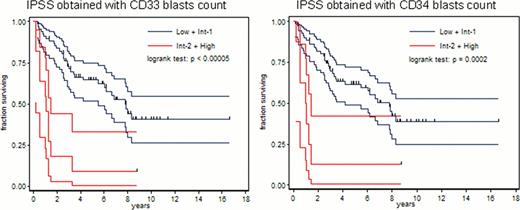Abstract
Abstract 4945
bone marrow blast count is a crucial parameter to determinate the prognostic score according to IPSS in myelodysplastic syndromes. However even among the major experts the agreement about detection of a blast cells by optical microscopy is less than 90% (Mufti et al: Haematologica 2008). The aim of this study is to evaluate prognostic significance of immunocytometric count of medullar blasts compared to cytological count.
in a retrospective analysis of 104 patients with a minimum follow-up of three years, IPSS was calculated replacing cytological count of blasts with the flow cytometry one. Blasts were expressed as percentages of total cellularity, and identified by the combination of CD45/SSC with/without CD33, CD34 and CD117 antigens. The monoclonal antibodies used were CD34 FITC, CD117 PE, CD45 PerCp, CD33 APC. Acquisition of information on 1×105 stained cells corresponding to the whole bone marrow cellularity was assessed on a dual-laser FACSCalibur flow cytometer using the CellQUEST software (Becton Dickinson, San José CA USA). Survival of “low + intermediate-1 risk” (“IPSS1+2”) patients was compared to “intermediate-2 + high risk” ones (“IPSS3+4”) using Kaplan Meier method followed by logrank test. The comparison of ability among all blast count models to distinguish the probability of survival of the two groups (“IPSS 1+2” vs “IPSS3+4”) was based on χ2 value obtained by the logrank test.
considering IPSS obtained from any of the immunocytometric markers considered (CD33, CD34, CD117 and CD45dim/SSC), “IPSS1+2” group had always an extremely better survival than “IPSS 3+4” group with a level of statistical significance similar to survival study of “standard IPSS”. Of all markers, CD45dim/SSC was the most capable to distinguish survival of “IPSS1+2” group versus “IPSS3+4” group (χ2 = 42. 5). Among others, CD117 and CD33 had a better discriminating power than cytological count (respectively χ2 = 38, 1 and χ2 = 22, 3 versus χ2 18, 2); only CD34 was worse than cytological count (χ2 =14, 2).
the immunocytometric markers considered are demonstrated to be even better than cytological count as parameter in IPSS score. Their use has to be encouraged, especially where there is little experience in optical microscopy.
No relevant conflicts of interest to declare.
Author notes
Asterisk with author names denotes non-ASH members.




This feature is available to Subscribers Only
Sign In or Create an Account Close Modal